Constraints on sedimentary ages of the Chuanlinggou Formation in the Ming Tombs,Beijing,North China Craton:LA-ICP-MS and SHRIMP U–Pb dating of detrital zircons
2018-06-27JingDingYuruoShiAlfredKrnerLawfordAnderson
Jing Ding •Yuruo Shi •Alfred Kröner,3 •J.Lawford Anderson
1 Introduction
Zircon has stable physical and chemical properties,being rich in U and Th,with low Pb and a low ion diffusion rate.The zircon U–Pb isotopic system is ideally suited for U–Pb dating and generally records the time of zircon crystallization because of a high closure temperature for the U–Pb isotopic system and is minimally affected by later thermal events when compared with other isotopic systems(Lee et al.1997;Cherniak et al.1997;Cherniak and Watson 2001;Poitrasson et al.2002;Corfu et al.2003).
Clastic components in sedimentary rocks are products of weathering,denudation,transportation,and sedimentation of rocks from their source region.Detrital zircons are resistant to weathering and abrasion,and they preserve an age record of their original host rocks.Therefore,detrital zircon chronology is a potentially powerful tool to constrain sedimentary provenance,leading to a better understanding of the source area,the regional palaeogeography,the depositional age,and the tectonic relationship between different crustal terranes supplying detritus(Krogh et al.1990;Sircombe and Freeman 1999;Yao et al.2011;Cawood and Nemchin 1999;Kositcin and Krapež2004;Wan et al.2011;Hu et al.2009,2013).
The North China Craton(NCC),which is located north of the Qinling-Dabie Orogenic Belt and south of the Central Asian Orogenic Belt,is the largest craton in eastern Asia and one of the oldest cratons on Earth.The NCC experienced multi-stage cratonization processes and eventually formed a stable craton in the Late Neoarchean(Cheng 1994;Bai et al.1993;Zhao 1993;Shen et al.1992;Lu et al.1996;Li et al.2000;Zhai 2011;Wan et al.2015).Vertically,the NCC has a typical double-layer structure consisting of an older crystalline basement and younger sedimentary cover deposited unconformably after 1.8 Ga(Li et al.2006).The Changcheng Group,the first sedimentary cover,is considered the beginning of the Mesoproterozoic in the regional stratigraphic chart in China.The boundary age between the Paleoproterozoic and the Mesoproterozoic is ca.1800 Ma in China(All China Commission of Stratigraphy 2001),but 1600 Ma in the International Geological Time Scale.Thus,many researchers have studied the depositional time of the Changcheng Group(Wan et al.2003,2011;Li et al.2011,2013a,b;Gao et al.2008,2009;Peng et al.2012;Zhang et al.2013).Past studies on the depositional time of the Chuanlinggou Formation of the Changcheng Group included dating of intrusives(Gao et al.2009;Zhang et al.2013),detrital minerals(Wan et al.2011;Zhang et al.2015;Duan et al.2014),interbedded volcanic tuffs(Sun et al.2013)and authigenic minerals(Zhang et al.2015).However,the deposition time of the Chuanlinggou Formation and its sedimentary environment are still controversial.
This paper reports LA-ICP-MS and SHRIMP U–Pb data derived from detrital zircons of five sedimentary samples that were collected from the bottom of the Chuanlinggou Formation of the Changcheng Group in the Ming Tombs area and Beijing.These data provide new evidence for study of the sedimentary age,provenance of the Chuanlinggou Formation,and the Precambrian geological evolution of the NCC.
2 Geological setting and sample description
The Precambrian units of the NCC consist of the Archean-Paleoproterozoic crystalline basement and the overlying Meso-Neoproterozoic sedimentary strata(Fig.1).Consolidation of the basement marks the end of the Paleoproterozoic Era and deposition of the cover marks the beginning of the Mesoproterozoic Era.The Lüliang Movement(1900–1800 Ma)has been considered the ultimate consolidation of the NCC basement.Afterwards,the stabilized NCC entered a platform phase,which is also the named stage of the development and evolution of a rift system(Zhai et al.2014).This is because such rifting occurred in the interior and along the margins of the NCC.In the north,such rifting formed the Yanliao aulacogen which reaches into the central region of the craton in a NESW direction.The thickness of the aulacogen is largest at Jixian,China(its depocenter within the aulacogen)and becomes thinner towards the margin.The Ming Tombs area is located in the middle of the aulacogen and its sedimentary fill include Meso-Neoproterozoic strata which rest unconformably on Archean gneisses.Of these,the strata of the Mesoproterozoic Changcheng Group consist of the Changzhougou,Chuanlinggou, Tuanshanzi,and Dahongyu Formations,in ascending order.
Samples MC1 to MC5,in ascending order,were collected from the Chuanlinggou Formation in the Ming Tombs District,Beijing(Fig.2).The Chuanlinggou Formation is in conformable contact with the underlying Changzhougou Formation(Hebei Bureau of Geology and Mineral Resources 1982).Sample MC1 was collected 44 cm above the contact between the Changzhougou and Chuanlinggou formations,with alatitude and longitude of N40°17′56.8′,E116°10′55.8′;the lithology is a silty mudstone,composed of 75%clay minerals,15%quartz,7%mica and 3%feldspar(Fig.3).Siltstone sample MC2 is composed of quartz(70%),feldspar(20%),and mica(10%).Sample MC3 is composed of laminated siltstone and fine-grained sandstone with unequal thickness between 0.05 and 0.5 mm.Sample MC4 is a fine-grained sandstone with siliceous cement and a grain-supported structure and its clastic components are mainly quartz(about 90%).Sample MC5 is a fine-grained dolomite,composed of 90%dolomite,6%quartz,2%calcite and 2%feldspar,with particle sizes of most grains about 0.08 mm and is fairly well sorted.
3 Analytical techniques
The sediment samples were crushed mechanically and heavy mineral concentrates were prepared using standard heavy liquid and magnetic separation techniques.Zircons were extracted from the heavy mineral concentrate by hand-picking under a binocular microscope,mounted in epoxy,and polished to expose the cores of individual grains.The grain mount was then photographed in reflected light,cleaned,and gold-coated.Cathodoluminescence(CL)imaging was done using a scanning electron microscope(HITACHI S3000-N) fitted with a GATAN Chroma at the Beijing SHRIMP Center,Institute of Geology,Chinese Academy of Geological Sciences.
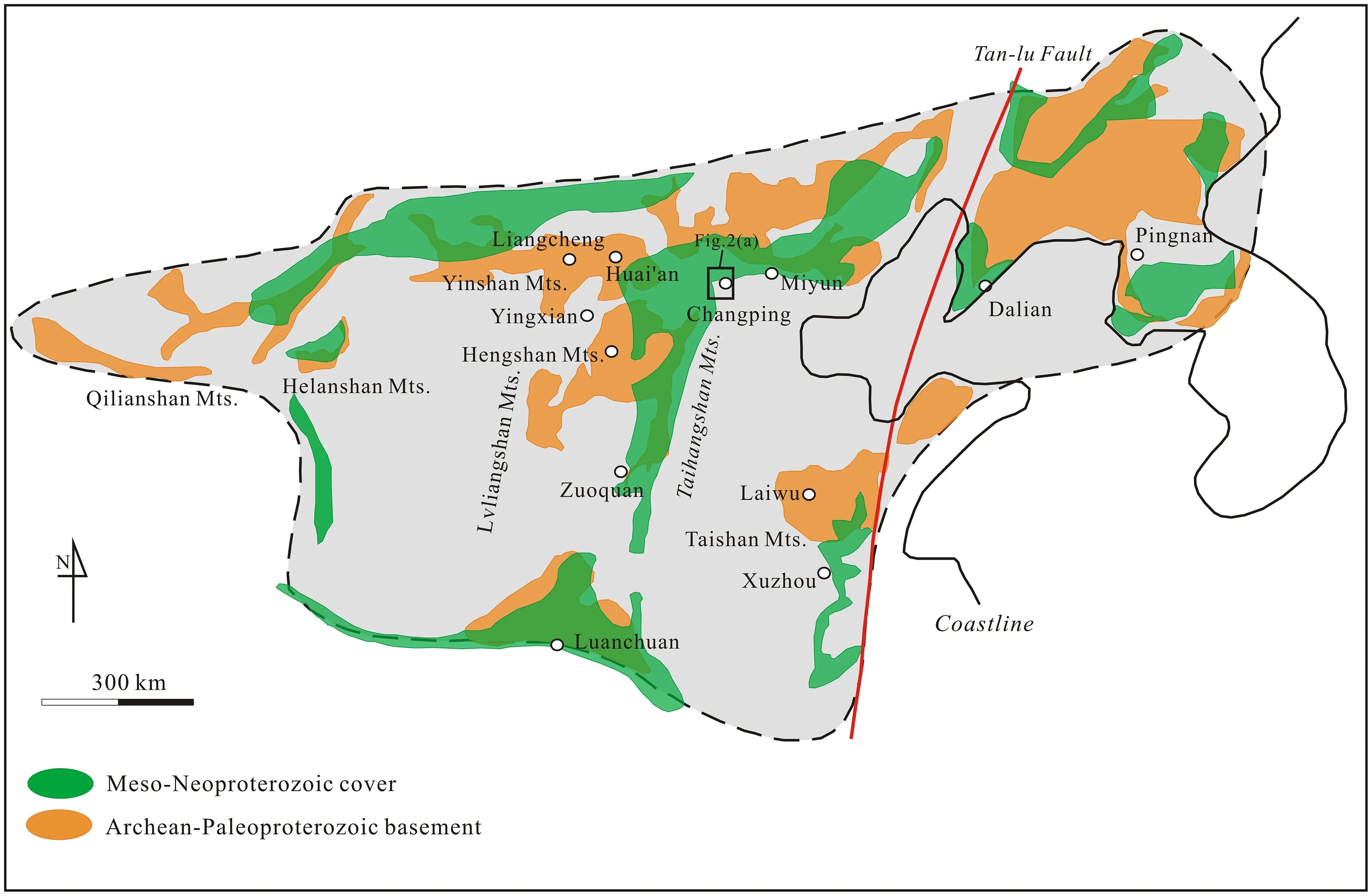
Fig.1 Distribution of Archean-Paleoproterozoic crystalline basement and Meso-Neoproterozoic cover in the North China Craton.Modified from Peng et al.(2011)
The LA-ICP-MS analytical work was performed at the Institute of Mineral Resources,Chinese Academy of Geological Sciences,Beijing.The laser ablation system analyses were conducted on a Newwave UP213 and the ICP-MS analyses were done on a Bruker M90 model.The laser ablation spot diameter was 25 μm,the output frequency was 10 Hz and energy densities were about 2.5 J/cm2.Helium gas was used as a carrier gas and Ar was used as a compensation gas to adjust sensitivity.They were mixed together through a Y-connector before entering the ICP during laser ablation analyses.The data were processed off-line using ICPMSDataCal(Liu et al.2010;Hou et al.2009).Detailed instrument operating conditions and data processing methods were similar to those described by Hou et al.(2009).The GJ-1 standard(206Pb/238U age of 600 Ma,Jackson et al.2004)was used to calibrate the instrument and to reach its optimal state prior to the analysis.Trace elements in zircon were calculated quantitatively using SRM610 as the external standard and Si as the internal standard(Liu et al.2010).Recommended element values of USGS reference glasses came from the GeoReM database(http://georem.mpch-mainz.gwdg.de/).Isotope fractionation was corrected using the external standard GJ-1.GJ-1 was analyzed twice and the zircon standard Plesovice(206Pb/238U age of 337.13±0.37 Ma,Sláma et al.2008)was analyzed once after every ten analyses of unknowns.The instrument was monitored during the entire analytical process to ensure the accuracy of the test.Time-related drift in U–Th–Pb isotope ratios was corrected by applying a linear interpolation using changes in GJ-1(Liu et al.2010).Construction of U–Pb age spectra for detrital zircons and calculation of weighted mean ages were performed using the Isoplot program(Ludwig 2003).Errors for single data points are at the 1σ level.
SHRIMP II zircon analyses were performed in the Beijing SHRIMP Center,Institute of Geology,Chinese Academy of Geological Sciences,and the analytical procedures follow those of Williams(1998).Spot sizes were 25–30 μm and the surface of the analysis site was rastered for 3 min prior to each analysis to remove the gold coating.Data were determined by taking 3 scans on90Zr126O+,204Pb+,Background,206Pb+,207Pb+,208Pb+,238U+,232Th16O+,238U16O+.Standard zircon M257,with an age of 561.3±0.3 Ma and U content of 840 ppm(Nasdala et al.2008),was used to calibrate U and Th content.Reference zircons Qinghu(159.5±0.2 Ma,Li et al.2013a,b)and TEMORA(417 Ma,Black et al.2003a)were performed during the analytical session to calibrate the U–Pb age of the unknown.Common Pb corrections were made using the measured204Pb.Uncertainties for each analysis are at 1σ.Data were processed using the Excelbased Squid(Ludwig 2001)and Isoplot(Ludwig 2003)programs.
We used207Pb/206Pb to represent the diagenetic age because it is believed to be more reliable as ancient zircons(>1000 Ma)usually have some degree of lead loss(Black et al.2003b).
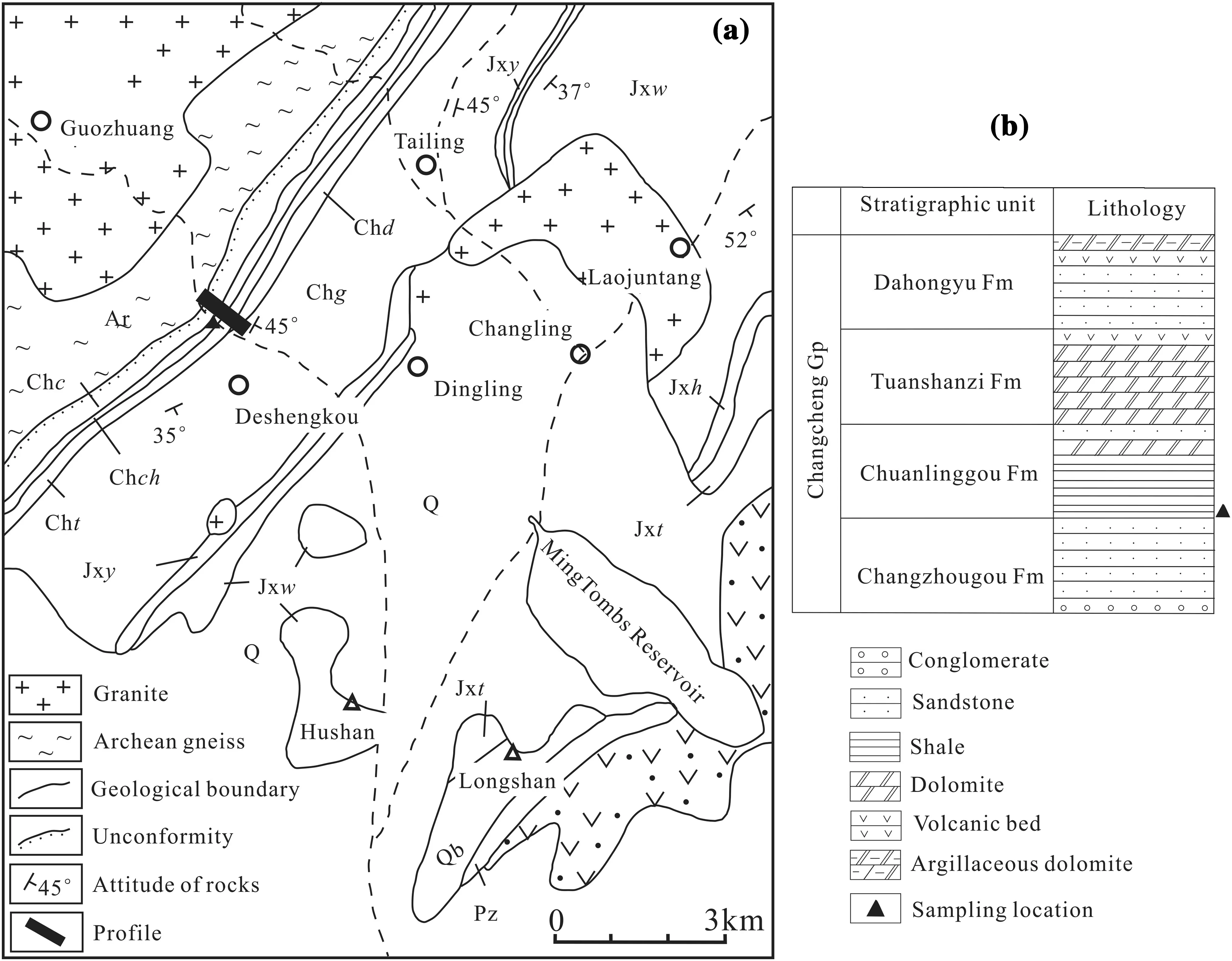
Fig.2 Geological map of the ming tombs area of Beijing(Q Quaternary System;Jxt Tieling Formation;Jxh,Hongshuizhuang Formation;Jxw Wumishan Formation;Jxy Yangzhuang Formation;Qb Qingbaikou System;Chg Gaoyuzhuang Formation;Chd Dahongyu Formation;Cht Tuanshanzi Formation;Chch Chuanlinggou Formation;Chc,Changzhougou Formation;Ar Archean).a Modified from Zhang et al.(2002)and column of strata lithology of the Changcheng Group,b modified from Lan et al.(2014)
4 Results
Zircons in samples MC1 to MC5 are mostlyroundedor columnar in shape, and their sizes are between 30 and 150 μm. Most zircon grains show oscillatory zoning in CL images(Figs.4,5),indicating a magmatic origin.A few zircons have a dark core and a bright over growth,which indicates the sources of the sediments have experienced multiple tectonic-thermal events.
The number of analyses obtained from LA-ICP-MS U–Pb zircon dating are ninety-four,ninety-four,ninety-three,ninety-seven and ninety-two,respectively,from samples MC1 to MC5.The analytical results are listed in Table 1.About eighty zircon grains from sample MC5 were also dated by the U–Pb SHRIMP method and seventy-four analyses were obtained.The results are shown in Table 2.
Figure 6 shows the LA-ICP-MS U–Pb concordia diagrams and age spectra of detrital zircons of the five samples MC1 to MC5 from the bottom of the Chuanlinggou Formation.The U–Pb concordia diagrams show that most of the points deviate from concordia line,indicating the loss of radiogenic Pb.Most of the points in samples MC1,MC2 and MC4 also show a linear distribution.In samples MC3 and MC5,the points are a little scattered.It is evident that each sample has an age peak at 2500 Ma in the age spectra.The youngest zircon in sample MC2 is MC2-grain 28 with an age of ca.1677 Ma.Sample MC3 exhibits a major age peak at 2000 Ma and a secondary age peak at about 2500 Ma.Sample MC5 has two small peaks at 2000 Ma and 2300 Ma,besides a major peak at 2500 Ma.The youngest zircon(MC5-grain 72)in MC5 is 1673±44 Ma,which is also the youngest age of the five samples.
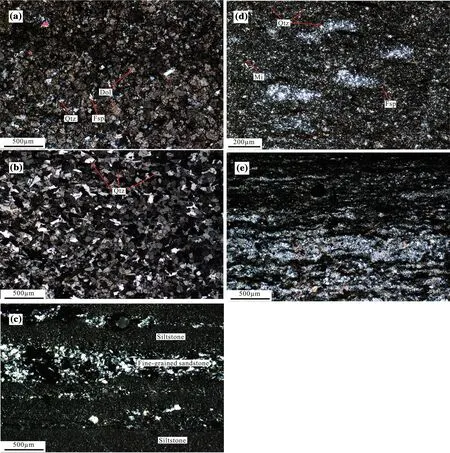
Fig.3 Photomicrographs of sedimentary rocks from the bottom of the Chuanlinggou Formation.a Sample MC5;b sample MC4;c sample MC3;d sample MC2;e sample MC1
Figure 7 is the SHRIMP U–Pb concordia diagram and age spectrum for the zircons of sample MC5.Most of the points distribute in the concordia curve.The age spectrum shows an age peak at about 2500 Ma.
The age spectrum for all the detrital zircons of the five sediments show a major peak at 2500 Ma and a secondary peak at 2000 Ma(Fig.8).
5 Disscussion
5.1 Constraints on sedimentary age of the Chuanlinggou Formation
The sedimentary age of the Chuanlinggou Formation can indirectly constrain the upper age limit of the Changzhougou Formation as the latter is overlain by the former.Moreover,the Chuanlinggou Formation has the first black shale series of the entire Yanliao aulacogen.Therefore,the geochronology of the Chuanlinggou Formation has great significance to both stratigraphic correlation and basin analysis(Meng et al.2011).

Fig.5 CL images of some detrital zircons(analyzed by SHRIMP)from sample MC5
Sun et al.(2013)reported that the age of the volcanic tuff rock from the upper part of the Chuanlinggou Formation is 1621±12 Ma.Zircons from a dioritic porphyrite dyke emplaced into the Chuanlinggou Formation yield an age of 1634±9 Ma(Zhang et al.2013),indicating sedimentation of the Chuanlinggou Formation prior to 1634±9 Ma.Duan et al.(2014)limited the maximum deposition age of the Chuanlinggou Formation according to four younger ages of magmatic zircons from the Chuanlinggou Formation in Jiangjiazhai iron deposit,and the age range is reported as 1657.4 to 1694.4 Ma.Gao et al.(2009)reported that the age of the diabase of the Chuanlinggou Formation is 1638±14 Ma.
In this study,we find the youngest detrital zircon in the bottom sediments of the Chuanlinggou Formation is 1673±44 Ma(Fig.9),suggesting that the deposition of the Chuanlinggou Formation was after this age.This age provides new evidence for study of the sedimentary age of the Chuanlinggou Formation and is useful for optimizing Mesoproterozoic chronostratigraphic framework of China.
5.2 Provenance of detritus in the Chuanlinggou Formation
A huge age peak of 2500 Ma was shown in the age spectrum(Fig.8)and must reflect a major geological event in Late Neoarchean.Early Precambrian magmatism of the NCC occurred between 2500 and 2800 Ma,2500 Ma was the peak age of magmatic activity and crustal growth(Geng et al.2002;Shietal. 2012;Wanetal.2015).Therefore,it is most likely that the sediments of the Chuanlinggou Formation were derived from the crystalline basement of the NCC which was mainly composed of Late Neoarchean granitoid crust(Fig.10).
A secondary age peak at 2000 Ma was shown in Fig.8.To constrain provenance of the ca.2000 Ma detrital
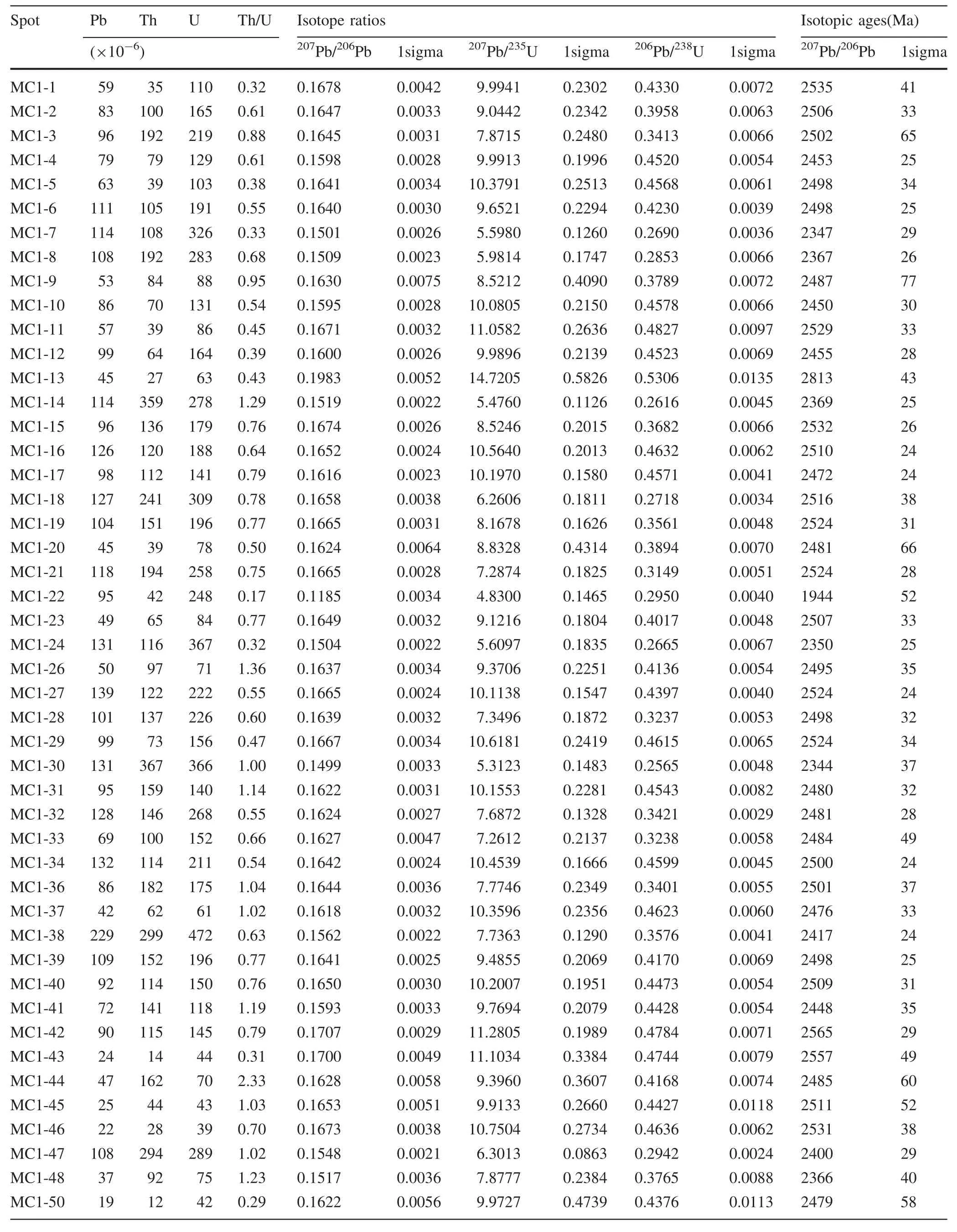
Table 1 LA-ICP-MS U–Pb analytical results of detrital zircons from the Chuanlinggou Formation in the Ming Tombs District,Beijing
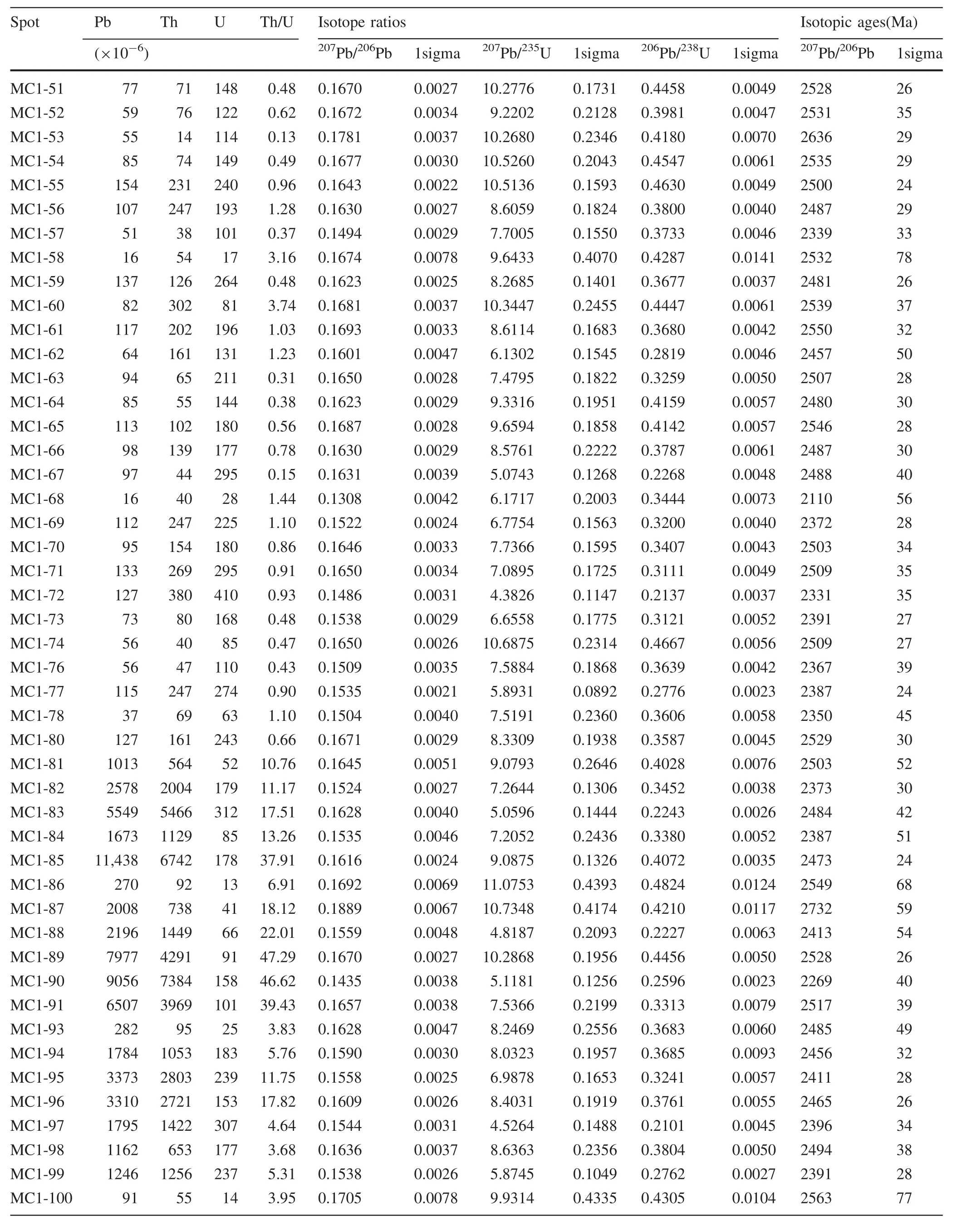
Table 1 continued
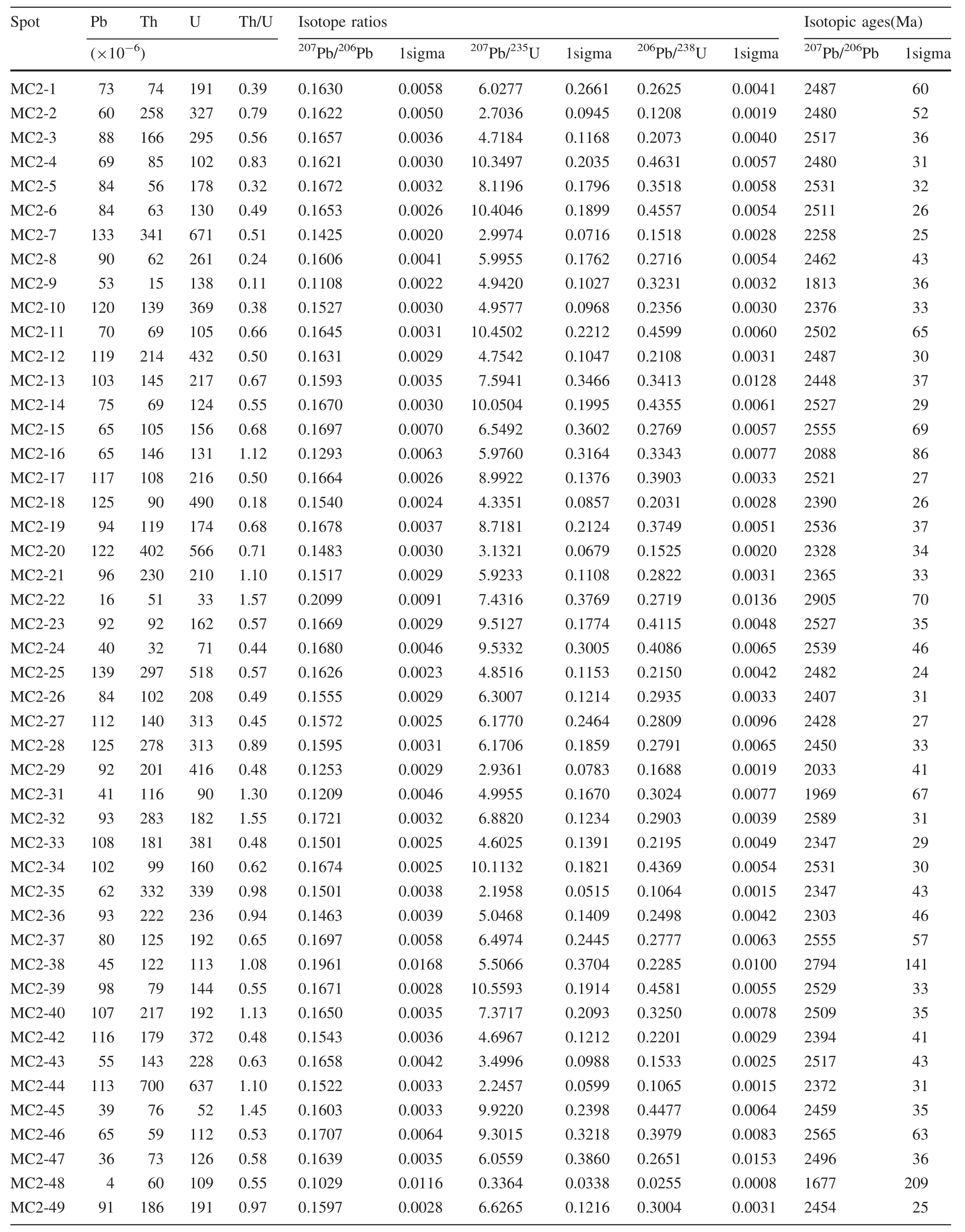
Table 1 continued
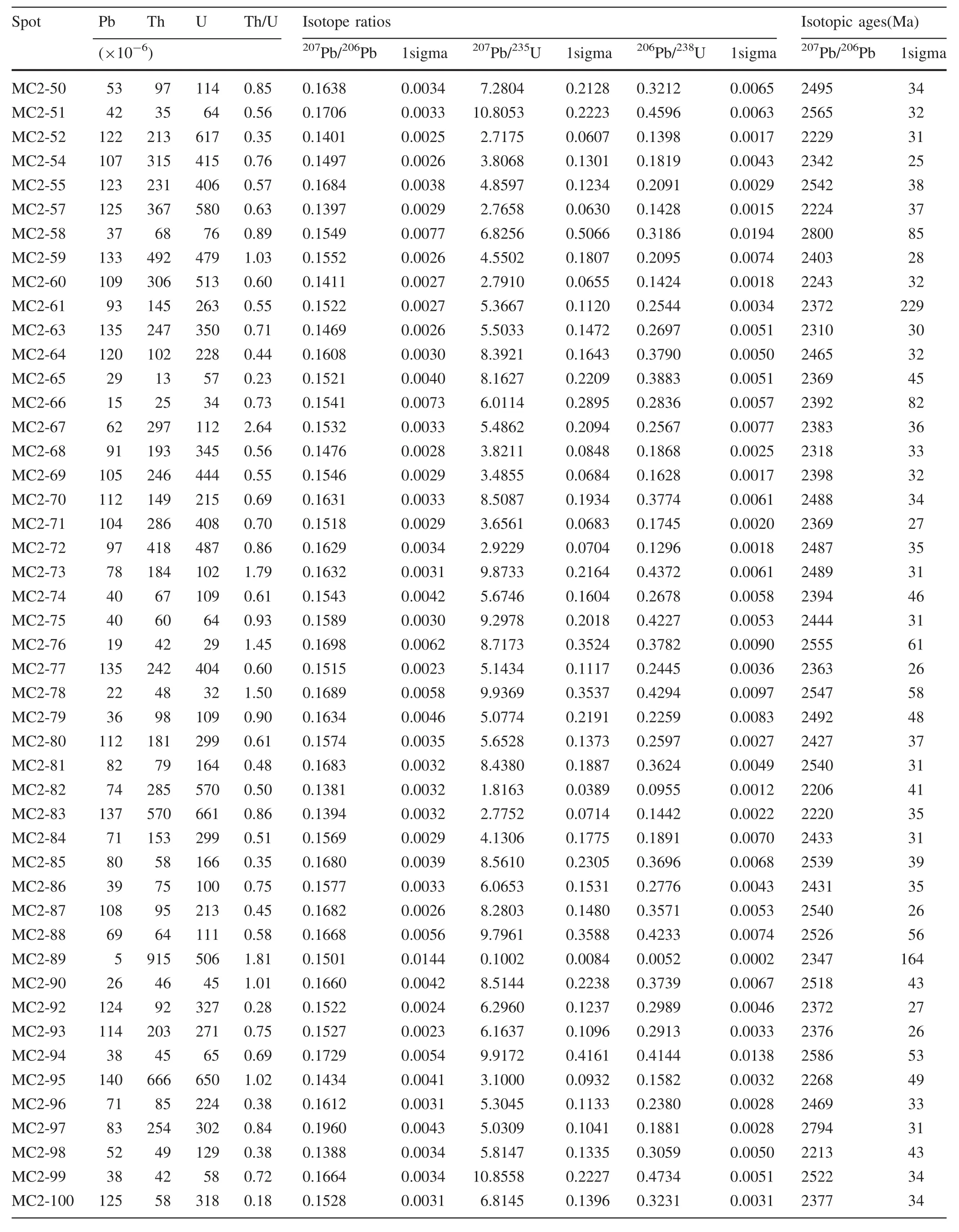
Table 1 continued
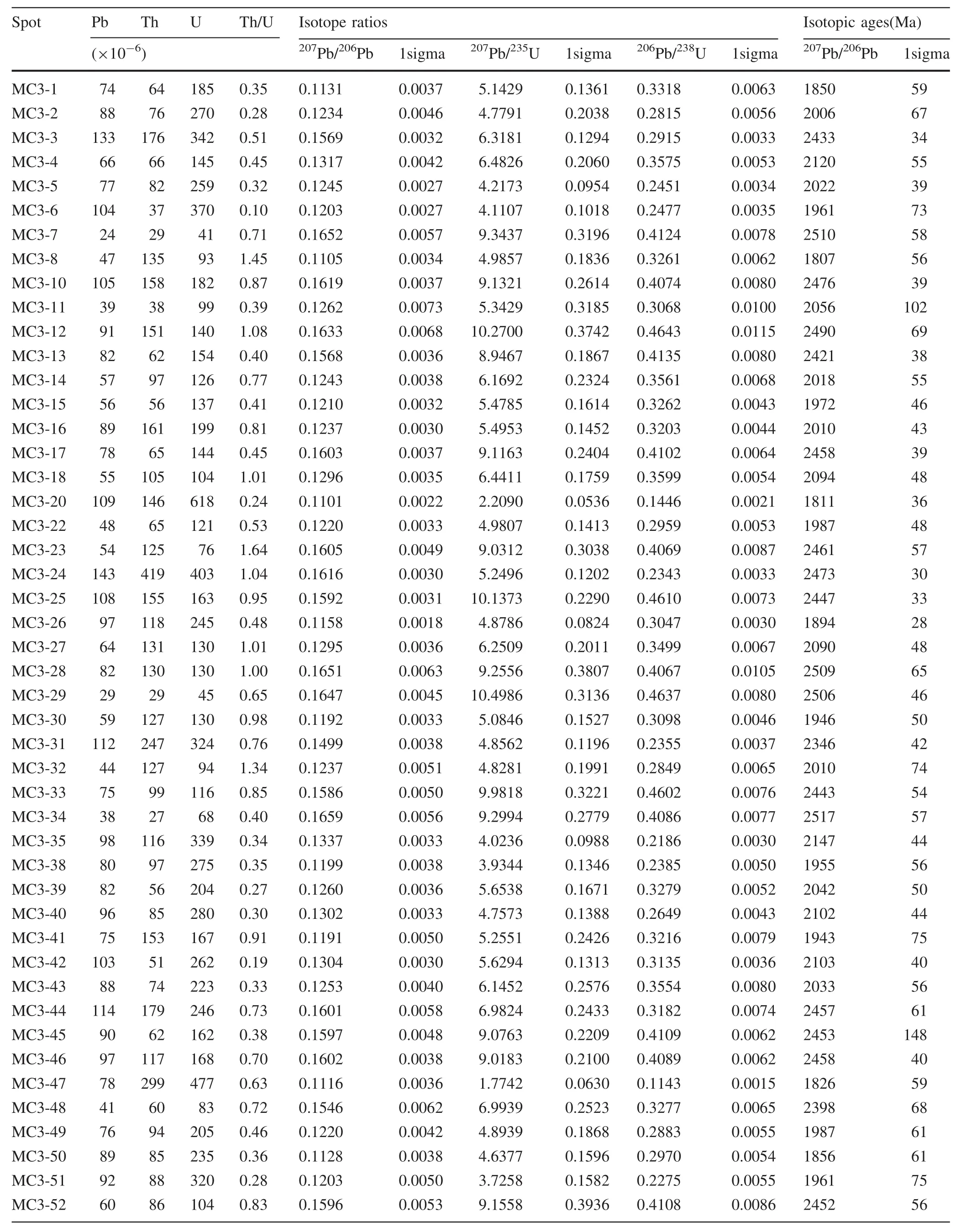
Table 1 continued
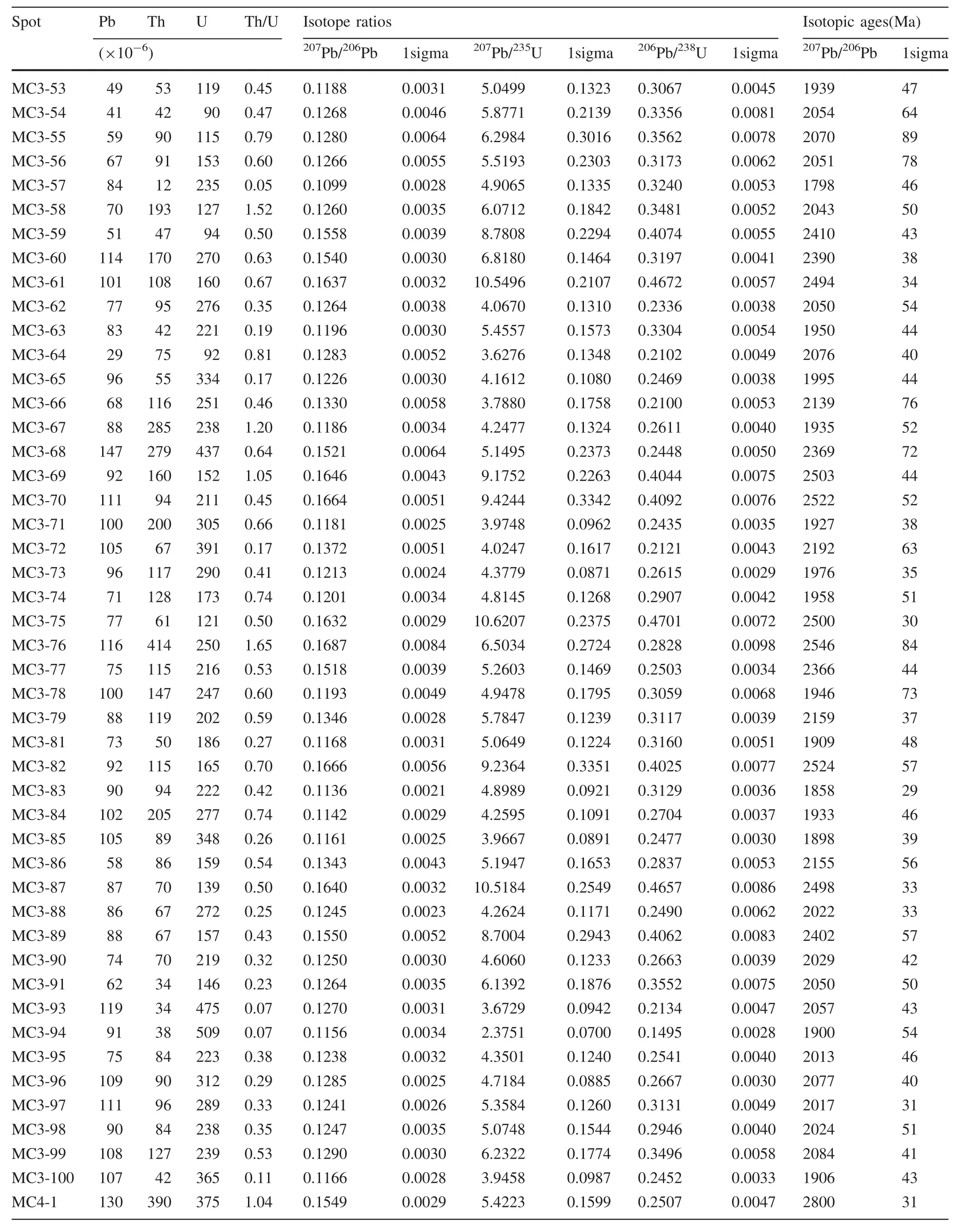
Table 1 continued
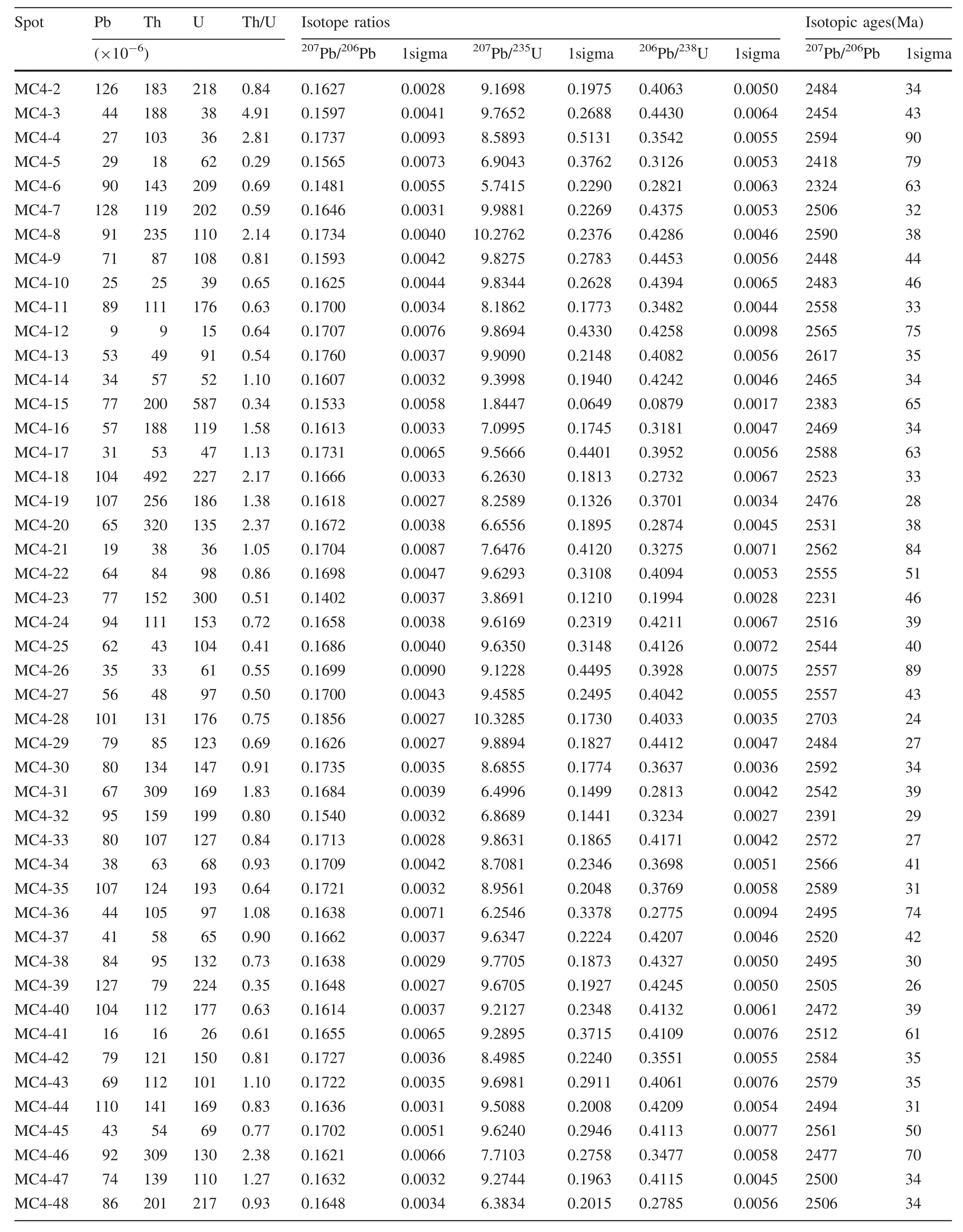
Table 1 continued
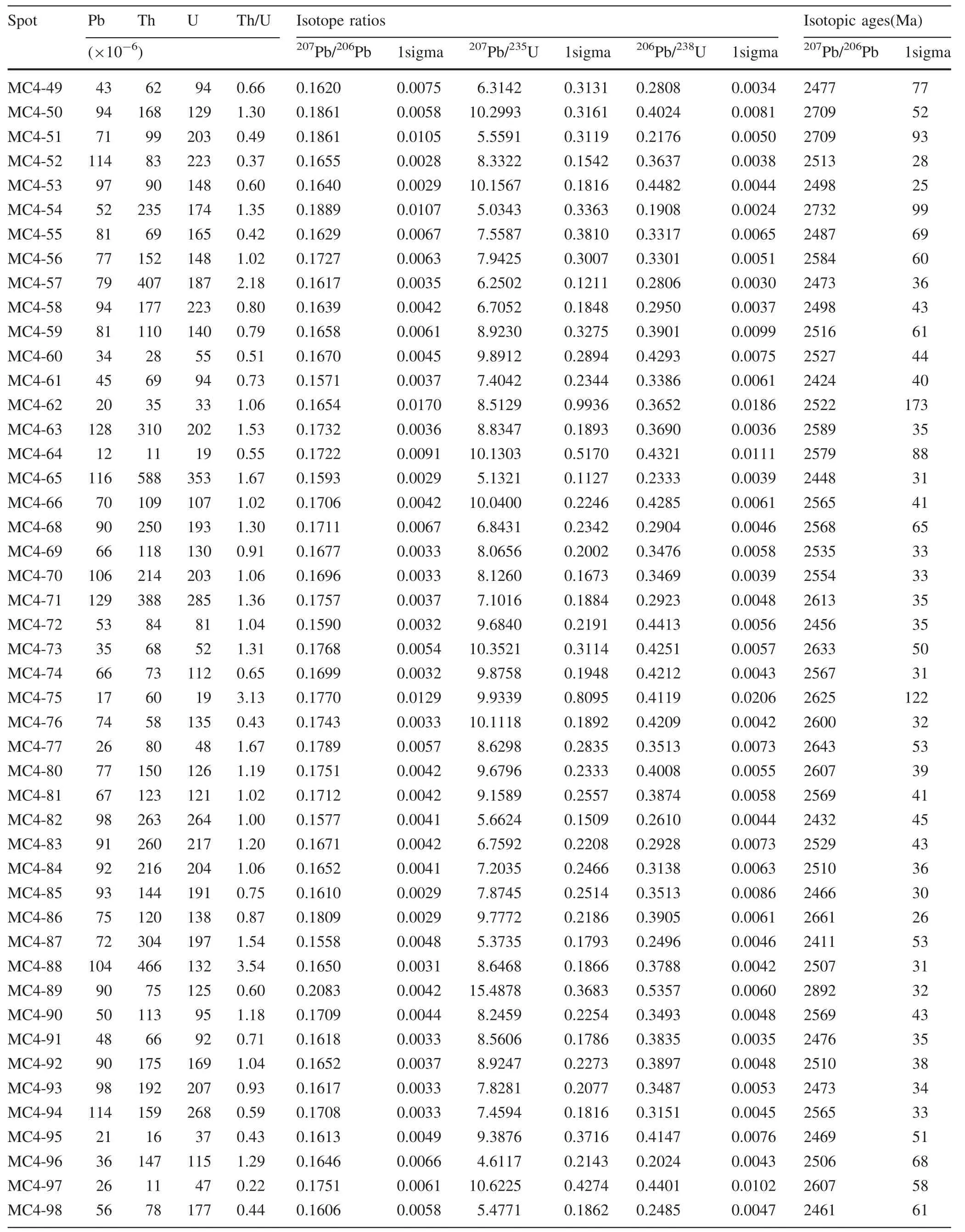
Spot Pb Th U Th/U Isotope ratios Isotopic ages(Ma)(×10-6) 207Pb/206Pb 1sigma 207Pb/235U 1sigma 206Pb/238U 1sigma 207Pb/206Pb 1sigma MC4-49 43 62 94 0.66 0.1620 0.0075 6.3142 0.3131 0.2808 0.0034 2477 77 MC4-50 94 168 129 1.30 0.1861 0.0058 10.2993 0.3161 0.4024 0.0081 2709 52 MC4-51 71 99 203 0.49 0.1861 0.0105 5.5591 0.3119 0.2176 0.0050 2709 93 MC4-52 114 83 223 0.37 0.1655 0.0028 8.3322 0.1542 0.3637 0.0038 2513 28 MC4-53 97 90 148 0.60 0.1640 0.0029 10.1567 0.1816 0.4482 0.0044 2498 25 MC4-54 52 235 174 1.35 0.1889 0.0107 5.0343 0.3363 0.1908 0.0024 2732 99 MC4-55 81 69 165 0.42 0.1629 0.0067 7.5587 0.3810 0.3317 0.0065 2487 69 MC4-56 77 152 148 1.02 0.1727 0.0063 7.9425 0.3007 0.3301 0.0051 2584 60 MC4-57 79 407 187 2.18 0.1617 0.0035 6.2502 0.1211 0.2806 0.0030 2473 36 MC4-58 94 177 223 0.80 0.1639 0.0042 6.7052 0.1848 0.2950 0.0037 2498 43 MC4-59 81 110 140 0.79 0.1658 0.0061 8.9230 0.3275 0.3901 0.0099 2516 61 MC4-60 34 28 55 0.51 0.1670 0.0045 9.8912 0.2894 0.4293 0.0075 2527 44 MC4-61 45 69 94 0.73 0.1571 0.0037 7.4042 0.2344 0.3386 0.0061 2424 40 MC4-62 20 35 33 1.06 0.1654 0.0170 8.5129 0.9936 0.3652 0.0186 2522 173 MC4-63 128 310 202 1.53 0.1732 0.0036 8.8347 0.1893 0.3690 0.0036 2589 35 MC4-64 12 11 19 0.55 0.1722 0.0091 10.1303 0.5170 0.4321 0.0111 2579 88 MC4-65 116 588 353 1.67 0.1593 0.0029 5.1321 0.1127 0.2333 0.0039 2448 31 MC4-66 70 109 107 1.02 0.1706 0.0042 10.0400 0.2246 0.4285 0.0061 2565 41 MC4-68 90 250 193 1.30 0.1711 0.0067 6.8431 0.2342 0.2904 0.0046 2568 65 MC4-69 66 118 130 0.91 0.1677 0.0033 8.0656 0.2002 0.3476 0.0058 2535 33 MC4-70 106 214 203 1.06 0.1696 0.0033 8.1260 0.1673 0.3469 0.0039 2554 33 MC4-71 129 388 285 1.36 0.1757 0.0037 7.1016 0.1884 0.2923 0.0048 2613 35 MC4-72 53 84 81 1.04 0.1590 0.0032 9.6840 0.2191 0.4413 0.0056 2456 35 MC4-73 35 68 52 1.31 0.1768 0.0054 10.3521 0.3114 0.4251 0.0057 2633 50 MC4-74 66 73 112 0.65 0.1699 0.0032 9.8758 0.1948 0.4212 0.0043 2567 31 MC4-75 17 60 19 3.13 0.1770 0.0129 9.9339 0.8095 0.4119 0.0206 2625 122 MC4-76 74 58 135 0.43 0.1743 0.0033 10.1118 0.1892 0.4209 0.0042 2600 32 MC4-77 26 80 48 1.67 0.1789 0.0057 8.6298 0.2835 0.3513 0.0073 2643 53 MC4-80 77 150 126 1.19 0.1751 0.0042 9.6796 0.2333 0.4008 0.0055 2607 39 MC4-81 67 123 121 1.02 0.1712 0.0042 9.1589 0.2557 0.3874 0.0058 2569 41 MC4-82 98 263 264 1.00 0.1577 0.0041 5.6624 0.1509 0.2610 0.0044 2432 45 MC4-83 91 260 217 1.20 0.1671 0.0042 6.7592 0.2208 0.2928 0.0073 2529 43 MC4-84 92 216 204 1.06 0.1652 0.0041 7.2035 0.2466 0.3138 0.0063 2510 36 MC4-85 93 144 191 0.75 0.1610 0.0029 7.8745 0.2514 0.3513 0.0086 2466 30 MC4-86 75 120 138 0.87 0.1809 0.0029 9.7772 0.2186 0.3905 0.0061 2661 26 MC4-87 72 304 197 1.54 0.1558 0.0048 5.3735 0.1793 0.2496 0.0046 2411 53 MC4-88 104 466 132 3.54 0.1650 0.0031 8.6468 0.1866 0.3788 0.0042 2507 31 MC4-89 90 75 125 0.60 0.2083 0.0042 15.4878 0.3683 0.5357 0.0060 2892 32 MC4-90 50 113 95 1.18 0.1709 0.0044 8.2459 0.2254 0.3493 0.0048 2569 43 MC4-91 48 66 92 0.71 0.1618 0.0033 8.5606 0.1786 0.3835 0.0035 2476 35 MC4-92 90 175 169 1.04 0.1652 0.0037 8.9247 0.2273 0.3897 0.0048 2510 38 MC4-93 98 192 207 0.93 0.1617 0.0033 7.8281 0.2077 0.3487 0.0053 2473 34 MC4-94 114 159 268 0.59 0.1708 0.0033 7.4594 0.1816 0.3151 0.0045 2565 33 MC4-95 21 16 37 0.43 0.1613 0.0049 9.3876 0.3716 0.4147 0.0076 2469 51 MC4-96 36 147 115 1.29 0.1646 0.0066 4.6117 0.2143 0.2024 0.0043 2506 68 MC4-97 26 11 47 0.22 0.1751 0.0061 10.6225 0.4274 0.4401 0.0102 2607 58 MC4-98 56 78 177 0.44 0.1606 0.0058 5.4771 0.1862 0.2485 0.0047 2461 61
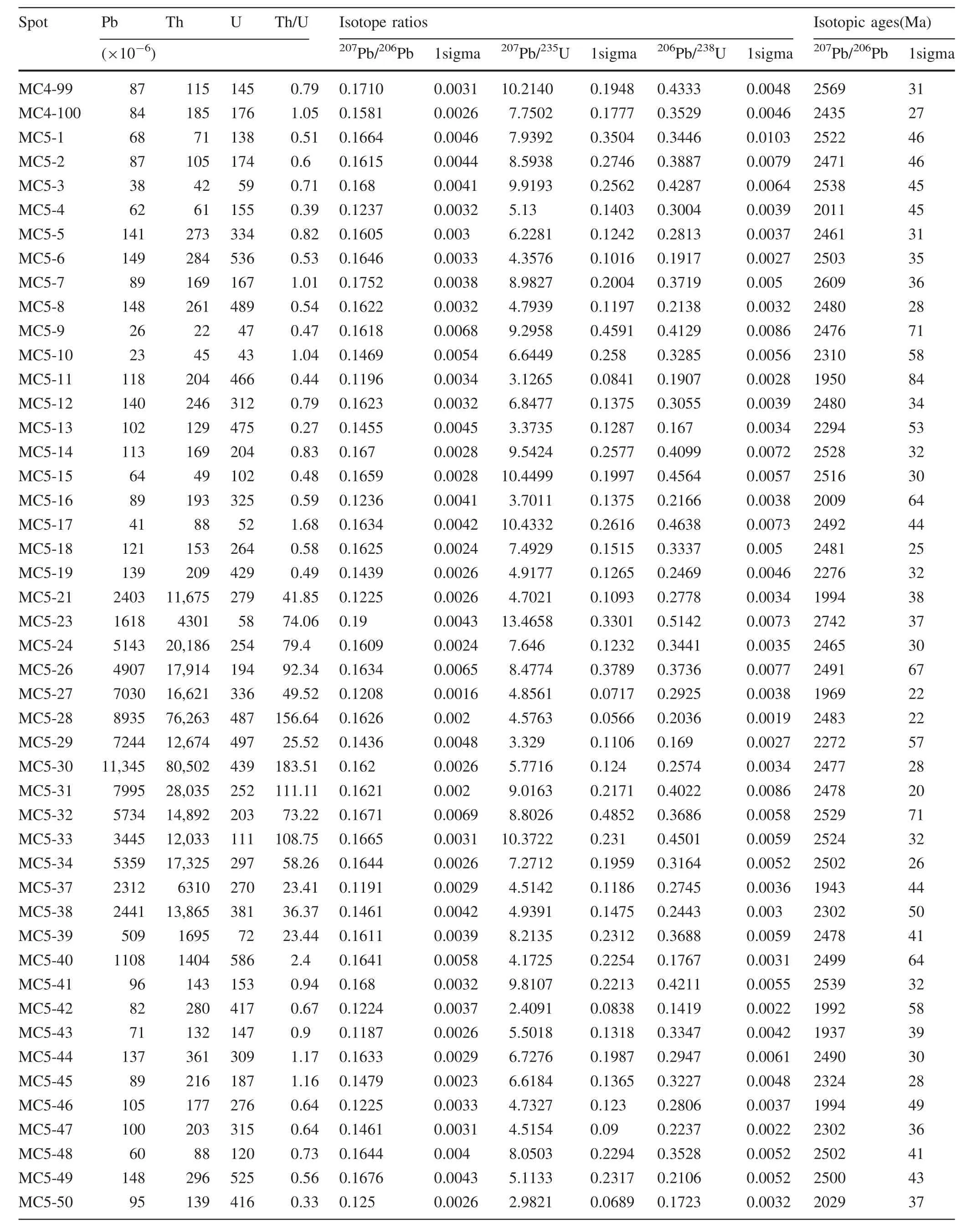
Table 1 continued

Table 1 continued
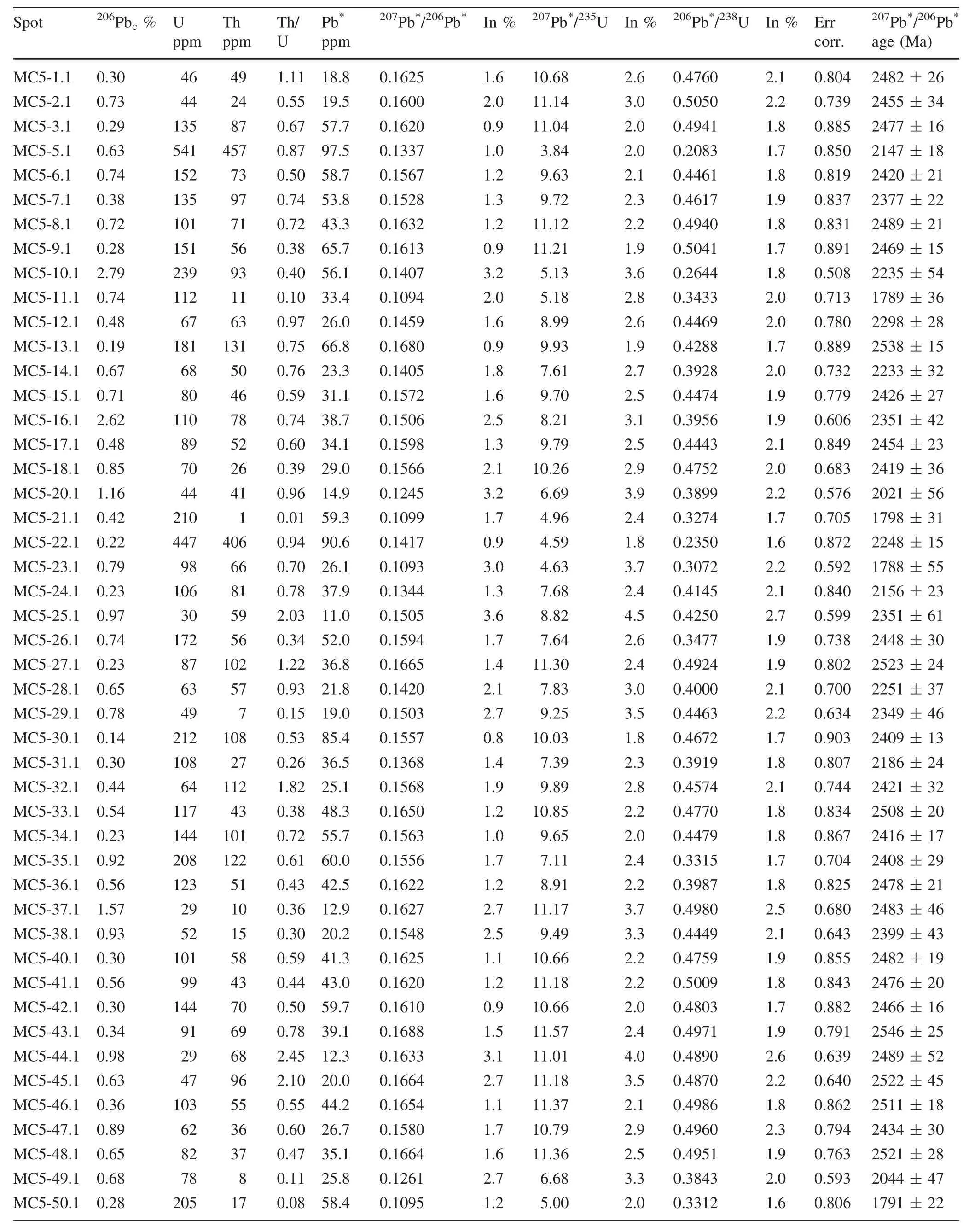
Table 2 SHRIMP U–Pb analytical results of detrital zircons from sample MC5 in the Chuanlinggou Formation

Table 2 SHRIMP U–Pb analytical results of detrital zircons from sample MC5 in the Chuanlinggou Formation
Table 1 continued materials,we collected and analyzed a large number of previously published age data and found that the detritus were most probably derived from the Trans-North China Orogen(TNCO)(Fig.10),which is believed to represent a collision zone resulting from the amalgamation of the Eastern and Western Blocks(Zhao et al.2002b,2006;Kusky et al.2007).The 2000 Ma age peak reflects a geological event which was coincident with the global collision events at 2.0–1.8 Ga and is recognized as the timing of the assembly of the Paleo-Mesoproterozoic super continent Columbia.
The ca.2000 Ma clastics from the TNCO were carried into the research area and then were firstly deposited in sample MC3.The age ranges of our detrital zircons show that the source for the Chuanlinggou Formation became more extensive the younger the sediment,suggesting that larger areas of Archean to Paleoproterozoic rocks were included as the deposition of the Chuanlinggou Formation progressed.
5.3 Transgressive event and analysis of the sedimentary environment
The age spectrum of sample MC5 shows a major peak at 2500 Ma and a secondary peak at 2000 Ma(Fig.6).Sample MC4,which is stratigraphically lower than MC5,only has one peak at 2500 Ma.The lithologies of the samples MC4 and MC5 changed from a clastic rock( finegrained sandstone)to a carbonate rock( fine-grained dolomite),suggesting that the depositional basin became progressively deeper.Combining with the zircon data,we suggest that this documents a transgressive event when sample MC5 was deposited,and seawater carried ca.2000 Ma clastic materials from the TNCO to the basin in which the Chuanlinggou Formation was deposited,leading to the addition of ca.2000 Ma detritus.
The Chuanlinggou Formation in the Yanshan area and the northern Taihang Mountain,had its maximumthickness at Jixian and Xinglong(Gao et al.2009).Song and Gao(1987)reported that the lower part of the Chuanlinggou Formation in the Ming Tombs District was deposited in a lagoonal environment.If the Chuanlinggou Formation was a lagoonal system,then its provenance would probably have been limited.However,our data show that the provenance became wider with time,adding more ca.2000 Ma clastic materials.Therefore,we do not think that the Chuanlinggou Formation in the Ming Tombs area reflects a lagoonal sedimentary environment.Instead,we suggest that the Chuanlinggou Formation reflects a low-energy mud flat sedimentary environment in the inter-supra tidal zone because the sediments mainly consist of silty mudstone and fine sandstone with relatively simple sedimentary structures(Fig.11).Of course,it is only a preliminary conclusion based on the obtained data fromthe present study.To draw a definite conclusion,further research on the lithology,lithologic composition,vertical distribution,spacial variation,etc.of the Chuanlinggou Formation in the Ming Tombs District should be made.

Fig.6 LA-ICP-MS U–Pb age concordia diagrams and age spectra for the detrital zircons of the samples MC1 to MC5
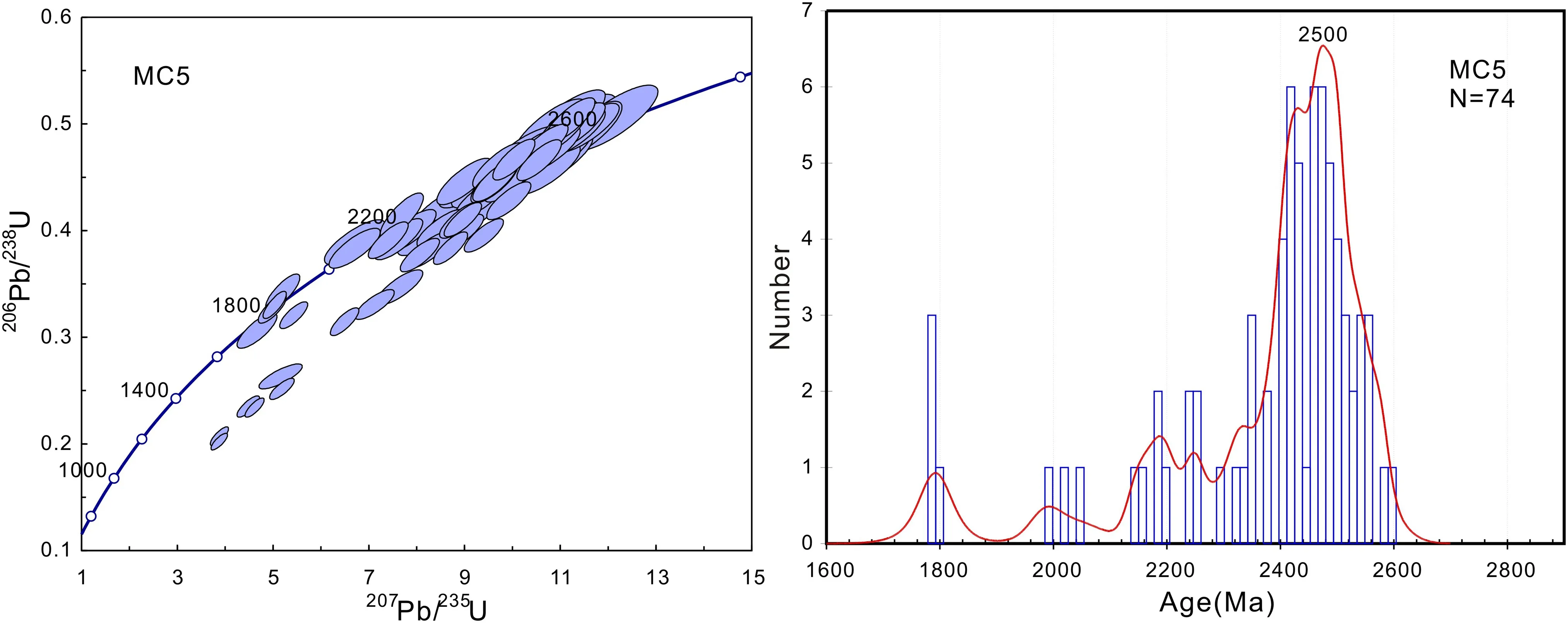
Fig.7 SHRIMP U–Pb age concordia diagram and age spectrum for the detrital zircons of the sample MC5
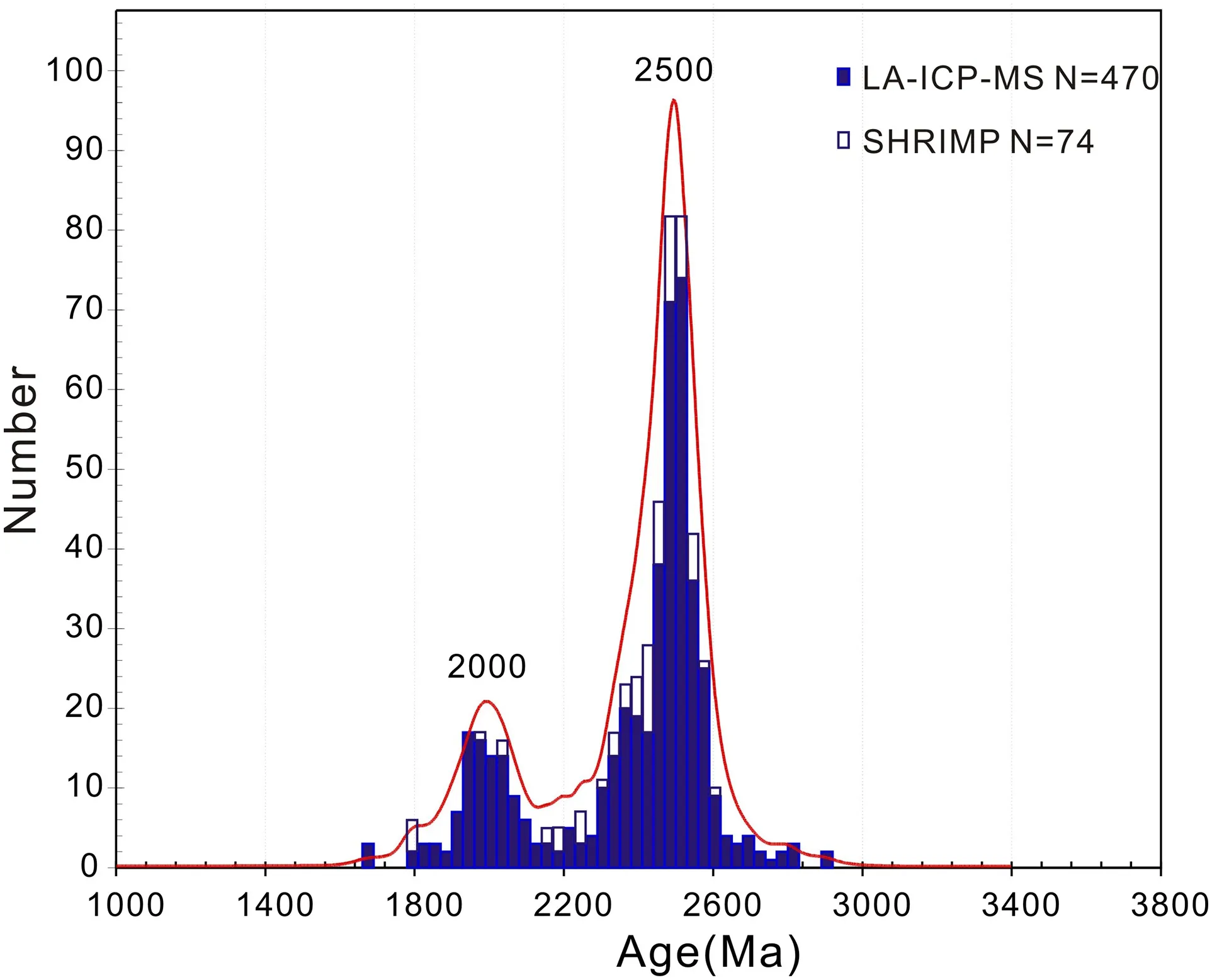
Fig.8 Age spectrum for all the detrital zircons of the Chuanlinggou Formation
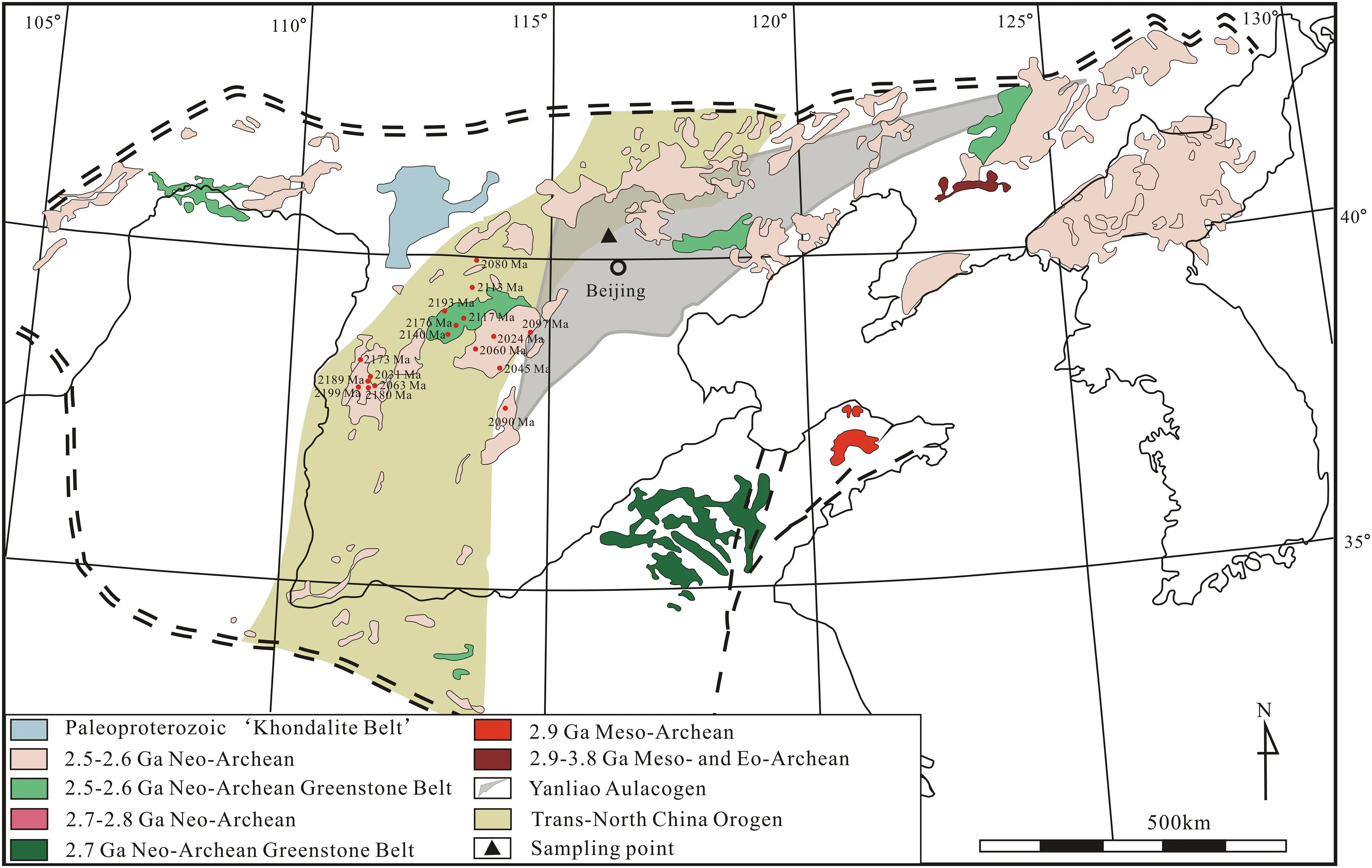
Fig.10 Distributions of Archean rocks in the North China Craton.Modified from Santosh et al.(2013)(the red circles show the available zircon age data from Du et al.(2010,2012,Geng et al.(2000),Guan et al.(2002),Kröner et al.(2005),Sun et al.(1991),Wang et al.(2000,2010),Wang and Wilde(2002)),Yang et al.(2011,Yu et al.(2004),Zhao et al.(2002a,b,2008,2011)
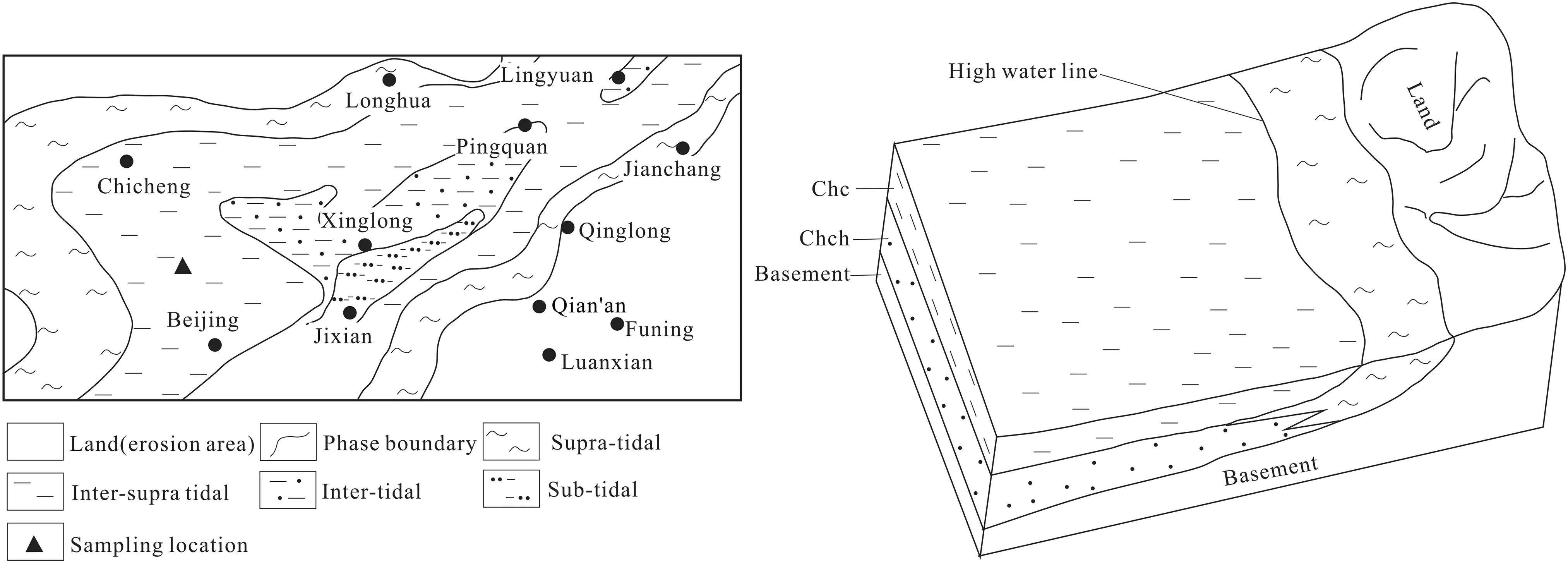
Fig.11 Paleoenvironment and sedimentary facies of the Chuanlinggou Formation in the Ming Tombs District,Beijing.Modified from He et al.(1994)
6 Conclusions
The youngest zircon age in the bottom sediments of the Chuanlinggou Formation is 1673±44 Ma,which suggests that the Chuanlinggou Formation was deposited after this age.The sediments in the Chuanlinggou Formation were derived from the crystalline basement of the NCC and the TNCO.According to the detrital zircon age range and rock types,we infer that transgressive event occurred when the Chuanlinggou Formation was deposited,which was in a low-energy mud flat sedimentary environment in the intersupra tidal zone.
AcknowledgmentsWe thank Professors Tianrui Song and Jiashan Wu for their comments and discussions,and thank Miss Weilin Gan and Qingmin Du for their help during mount making.This research was financially supported by the Ministry of Land and Natural Resources(Grant No.201311116),the National Natural Science Foundation of China(Grant No.41173065),Ministry of Science and Technology(No.2012FY120100),and the Basic Outlay of Scientific Research Work from the Ministry of Science and Technology(Grant No.J1403).
All China Commission of Stratigraphy(2001)Guide book and explanation of china stratigraphy(revised).Geological Publishing House,Beijing,pp 1–59(in Chinese)
Bai J,Huang XG,Dai FY,Wu CH(1993)The Precambrian evolution of China.Geological Publishing House,Beijing,pp 36–38(in Chinese)
Black LP,Kamo SL,Allen CM,Aleinikoff JN,Davis DW,Korsch RJ,Foudoulis C(2003a)TEMORA 1:a new zircon standard for phanerozoic U–Pb geochronology.Chem Geol 200:155–170
Black LP,Kamo SL,Williams IS,Mundil R,Davis DW,Korsch RJ,Foudoulis C(2003b)The application of SHRIMP to phanerozoic geochronology:a critical appraisal of four zircon standards.Chem Geol 200:171–188
Cawood PA,Nemchin AA(1999)U/Pb dating of detrital zircons:implications for the provenance record of Gondwana margin terranes.Geol Soc Am Bull 111:1107–1119
Cheng YQ (1994)Introduction to regional geology in China.Geological Publishing House,Beijing,pp 432–436(in Chinese)
Cherniak DJ,Watson EB(2001)Pb diffusion in zircon.Chem Geol 172:5–24
Cherniak DJ,Hanchar JM,Watson EB(1997)Diffusion of tetravalent cations in zircon.Contrib Miner Petrol 127:383–390
Corfu F,Hanchar JM,Hoskin PWO,Kinny P(2003)Atlas of zircon textures.Rev Mineral Geochem 53:469–500
Du LL,Yang CH,Guo JH,Wang W,Ren LD,Wan YS,Geng YS(2010)The age of the base of the Paleoproterozoic Hutuo Group in the Wutai Mountains area,North China Craton:SHRIMP zircon U–Pb dating of basaltic andesite.Chin SciBull 55:1782–1789
Du LL,Yang CH,Ren LD,Song HX,Geng YS,Wan YS(2012)The 2.2–2.1 Ga magmatic event and its tectonic implication in the Lüliang mountains.North China Craton.Acta Petrologica Sinica 28:2751–2769(in Chinese with English abstract)
Duan C,Li YH,Wei MH,Yang Y,Hou KJ,Chen XD,Zou B(2014)U–Pb dating study of detrital zircons from the Chuanlinggou Formation in Jiangjiazhai iron deposit,North China Craton and its geological significances.Acta Petrologica Sinica 30:35–48(in Chinese with English abstract)
Gao LZ,Zhang CH,Yin CY,Shi XY,Wang ZQ,Liu YM,Liu PJ,Tang F,Song B(2008)SHRIMP zircon ages:basis for refining the chronostratigraphic classification of the Meso-and Neoproterozoic strata in North China Old Land.Acta Geosci Sin 29:366–376(in Chinese with English abstract)
Gao LZ,Zhang CH,Liu PJ,Ding XZ,Wang ZQ,Zhang YJ(2009)Recognition of Meso-and Neoproterozoic stratigraphic framework in North and South China.Acta Geoscientica Sinica 30:433–446(in Chinese with English abstract)
Geng YS,Wan YS,Shen QH,Li HM,Zhang RX(2000)Chronological framework of the Early Precambrian important events in the Lüliang Area,Shanxi Province.Acta Geol Sin 74:216–223(in Chinese with English abstract)
Geng YS,Wan YS,Shen QH(2002)Early Precambrian basic volcanism and crustal growth in the North China Craton.Acta Geol Sin 76:199–208(in Chinese with English abstract)
Guan H,Sun M,Wilde SA,Zhou XH,Zhai MG(2002)SHRIMP U–Pb zircon geochronology of the fuping complex:implications for formation and assembly of the North China Craton.Precambr Res 113:1–18
He ZJ,Meng XH,Ge M(1994)Environmental evolutions and structural control of Changchengian of the Mid-Proterozoic in the Yanshan basin,North China.Acta Sedimentol Sin 12:10–19
Hebei Bureau of Geology and Mineral Resources(HBBGMR)(1982)Regional geology of Hebei Province,Beijing Municipality and Tianjin Municipality.Geological Publishing House,Beijing,pp 75–79(in Chinese)
Hou KJ,Li YH,Tian YR(2009)In situ U–Pb zircon dating using LAMC-ICP-MS.Mineral Deposits 28:481–492(in Chinese with English abstract)
Hu B,Zhai MG,Guo JH,Peng P,Liu F,Liu S(2009)LA-ICP-MS U–Pb geochronology of detrital zircons from the Huade Group in the northern margin of the North China Craton and its tectonic significance.Acta Petrologica Sinica 25:193–211(in Chinese with English abstract)
Hu B,Zhai MG,Peng P,Liu F,Diwu CR,Wang HZ,Zhang HD(2013)Late Paleoproterozoic to Neoproterozoic geological events of the North China Craton:evidences from LA-ICP-MS U–Pb geochronology of detrital zircons from the Cambrian and Jurassic sedimentary rocks in Western Hills of Beijing.Acta Petrologica Sinica 29:2508–2536(in Chinese with English abstract)
Jackson SE,Pearson NJ,Griffin WL,Belousova EA(2004)The application of laser ablation-inductively coupled plasma-mass spectrometry to in situ U–Pb zircon geochronology.Chem Geol 211:47–69
Kositcin N,KrapežB(2004)Relationship between detrital zircon age-spectra and the tectonic evolution of the Late Archaean Witwatersrand Basin,South Africa.Precambr Res 129:141–168
Krogh TE,Keppie JD(1990)Age of detrital zircon and titanite in the Meguma Group,southern Nova Scotia,Canada:clues to the origin of the Meguma Terrane.Tectonophysics 177:307–323
Kröner A,Wilde SA,Li JH,Wang KY(2005)Age and evolution of a Late Archean to Paleoproterozoic upper to lower crustal section in the Wutaishan/Hengshan/Fuping terrain of northern China.J Asian Earth Sci 24:577–595
Kusky TM,Li JH,Santosh M(2007)The Paleoproterozoic North Hebei Orogen:North China Craton’s collisional suture with the Columbia supercontinent.Gondwana Res 12:4–28
Lan ZW,Li XH,Chen ZQ,Li QL,Hofmann A,Zhang YB,Zhong Y,Liu Y,Tang GQ,Ling XX,Li J(2014)Diagenetic xenotime age constraints on the Sanjiaotang Formation,Luoyu Group,southern margin of the North China Craton:implications for regional stratigraphic correlation and early evolution of eukaryotes.Precambr Res 251:21–32
Lee J,Williams I,Ellis D(1997)Pb,U and Th diffusion in nature zircon.Nature 390:159–162
Li JH,Qian XL,Huang CN,Liu SW(2000)Tectonic framework of North China block and its cratonization in the Early Precambrian.Acta Petrologica Sinica 16:1–10(in Chinese with English abstract)
Li JH,Niu XL,Cheng SH,Qian XL(2006)The Early Precambrian tectonic evolution of continental craton:a case study from North China.Earth Sci 31:285–293
Li HK,Su WB,Zhou HY,Geng JZ,Xiang ZQ,Cui YR,Liu WC,Lu SN(2011)The base age of the Changchengian System at the northern North China Craton should be younger than 1670 Ma:constraints from zircon U–Pb LA-MC-ICPMS dating of a granite-porphyry dike in Miyun County,Beijing.Earth Sci Front 18:108–120(in Chinese with English abstract)
Li HK,Lu SN,Su WB,Xiang ZQ,Zhou HY,Zhang YQ(2013a)Recentadvances in the study of the mesoproterozoic geochronology in the North China Craton.J Asian Earth Sci 72:216–227
Li XH,Tang GQ,Gong B,Yang YH,Hou KJ,Hu ZC,Li QL,Liu Y,Li WX (2013b)Qinghu zircon:a working reference for microbeam analysis of U–Pb age and Hf and O isotopes.Chin Sci Bull 58:4647–4654
Liu YS,Gao S,Hu ZC,Gao CG,Zong KQ,Wang DB(2010)Continental and oceanic crust recycling-induced melt-peridotite interactions in the trans-North China Orogen:U–Pb dating,Hf isotopes and trace elements in zircons from mantle xenoliths.J Petrol 51:537–571
Lu SN,Yang CL,Jiang MM,Li HK,Li HM(1996)Tracing of Precambrian continental crust evolution.Geological Publishing House,Beijing,pp 137–140(in Chinese)
Ludwig KR(2001)Squid 102:a user’s manual.Berkeley Geochronology Centre,Special Publication,Berkeley,pp 1–19
Ludwig KR(2003)User’s manual for isoplot 3.00,a geochronological toolkit for microsoft excel.Berkeley Geochronology Center,Berkeley,pp 1–70
Meng QR,Wei HH,Qu YQ,Ma SX(2011)Stratigraphic and sedimentary records of the rift to drift evolution of the northern North China craton at the Paleo-to mesoproterozoic transition.Gondwana Res 20:205–218
Nasdala L,Hofmeister W,Norberg N,Mattinson JM,Corfu F,Dor W,Kamo SL,Kennedy AK,Kronz A,Reiners PW,Frei D,Kosler J,Wan YS,Goze J,Hoer T,Kröner A,Valley JW(2008)Zircon M257:a homogeneous natural reference material for the ion microprobe U–Pb analysis of zircon.Geostand Geoanal Res 32:247–265
Peng P,Bleeker W,Ernst RE,Söderlund U,McNicoll V(2011)U–Pbbaddeleyite ages,distribution and geochemistry of 925 Ma mafic dykes and 900 Ma sills in the North China Craton:evidence for a Neoproterozoic mantle plume. Lithos 127:210–221
Peng P,Liu F,Zhai MG,Guo JH(2012)Age of the Miyun dyke swarm:constraints on the maximum depositional age of the changcheng system.Chin Sci Bull 57:105–110
Poitrasson F,Hanchar JM,Schaltegger U(2002)The current state and future of accessory mineral research.Chem Geol 191:3–24
Santosh M,Liu DY,Shi YR,Liu SJ(2013)Paleoproterozoic accretionary orogenesis in the North China Craton:a SHRIMP zircon study.Precambr Res 227:29–54
Shen QH,Xu HF,Zhang ZQ,Gao JF,Wu JS,Ji CL(1992)Granulites of Early Precambrian in China.Geological Publishing House,Beijing,pp 389–400(in Chinese)
Shi YR,Wilde SA,Zhao XT,Ma YS,Du LL,Liu DY(2012)Late Neoarchean magmatic and subsequent metamorphic events in the northern North China Craton:SHRIMP zircon dating and Hf isotopes of Archean rocks from Yunmengshan geopark,Miyun,Beijing.Gondwana Res 21:785–800
Sircombe KN,Freeman MJ(1999)Provenance of detrital zircons on the Western Australia coastline–Implications for the geologic history of the Perth basin and denudation of the Yilgarn craton.Geology 27:879–882
Sláma J,Košler J,Condon DJ,Crowley JL,Cerdes A,Hanchar JM,Horstwood MSA,Morris GA,Nasdala L,Norberg N(2008)Plesovice zircon:a new natural reference material for U–Pb and Hf isotopic microanalysis.Chem Geol 249:1–35
Song TR,Gao J(1987)Precambrian sedimentary rocks of the Ming Tombs District,Beijing—a study of characteristics and facies indicators of the sedimentary rocks.Geological Publishing House,Beijing,pp 1–195(in Chinese with English abstract)
Sun DZ,Li HM,Lin YX,Zhou HF,Zhao FQ,Tang M(1991)Precambrian geochronology,chronotectonic framework and model of chronocrustal structure of the Zhongtiao mountains.Acta Geol Sin 3:216–231(in Chinese with English abstract)
Sun HY,Gao LZ,Bao C,Chen YL,Liu DY(2013)SHRIMP Zircon U–Pb of Mesoproterozoic Chuanlinggou Formation from Kuancheng County in Hebei Province and its geological implications.Acta Geol Sin 87:591–596(in Chinese with English abstract)
Wan YS,Zhang QD,Song TR(2003)Detrital zircon SHRIMP ages of the Changzhougou Formation,Changcheng system in the Ming Tombs,Beijing:material source of covering strata in the North China Craton and control on the oldest sedimentary time.Chin Sci Bull 48:1970–1975(in Chinese)
Wan YS,Liu DY,Wang W,Song TR,Kröner A,Dong CY,Zhou HY,Yin XY(2011)Provenance of Meso-to Neoproterozoic cover sediments at the Ming Tombs,Beijing,North China Craton:an integrated study of U–Pb dating and Hf isotopic measurement of detrital zircons and whole-rock geochemistry.Gondwana Res 20:219–242
Wan YS,Liu DY,Dong CY,Xie HQ,Kröner A,Ma MZ,Liu SJ,Xie SW,Ren P(2015)Formation and evolution of Archean continental crust of the North China Craton.Precambrian geology of China.Springer,Berlin,pp 59–136
Wang KY,Wilde S(2002)Precise SHRIMP U–Pb ages of dawaliang granite in Wutaishan area,Shanxi Province.Acta Petrol Mineral 21:407–420(in Chinese with English abstract)
Wang KY,Hao J,Wilde S,Cawood P(2000)Reconsideration of some key geological problems of Late Archean-Early Proterozoic in the Wutai-Hengshan area:constraints from SHRIMP U–Pb zircon data.Chin J Geol 35:175–184(in Chinese with English abstract)
Wang ZZ,Wilde SA,Wan JL(2010)Tectonic setting and significance of 2.3-2.1 Ga magmatic events in the Trans-North China Orogen:new constraints from the Yanmenguan mafic–ultramafic intrusion in the Hengshan–Wutai–Fuping area.Precambr Res 178:27–42
Willians IS(1998)U-Th-Pb geochromology by ion microprobe,applications of microanalytical techniques to understanding mineralizing processes(Eds.McKibben M.A.,Shanks,W.C.,Ridley W.I.).Rev Econ Geol 7:1–35
Yang CH,Du LL,Ren LD,Song HX,Wan YS,Xie HQ,Liu ZX(2011)The age and petrogenesis of the Xuting granite in the Zanhuang Complex,Hebei Province:constraints on the structural evolution of the Trans-North China Orogen,North China Craton.Acta Petrol Sin 27:1003–1016(in Chinese with English abstract)
Yao J,Shu L,Santosh M(2011)Detrital zircon U–Pb geochronology,Hf-isotopes and geochemistry—new clues for the Precambrian crustal evolution of Cathaysia Block,South China.Gondwana Res 20:553–567
Yu JH,Wang DZ,Wang CY,Wang LJ(2004)Paleoproterozoic granitic magmatism and metamorphism in middle part of Lüliang Range,Shanxi Province.Geol J China Univ 10:500–513(in Chinese with English abstract)
Zhai MG (2011)Cratonization and the Ancient North China continent:a summary and review.Sci China Earth Sci 54:1110–1120(in Chinese)
Zhai MG,Hu B,Peng P,Zhao TP(2014)Meso-Neoproterozoic magmatic events and multi-stage rifting in the NCC.Earth Sci Front 1:100–119(in Chinese with English abstract)
Zhang QD,Song TR,He ZJ,Ding XZ(2002)Pb–Pb age determination of Meso-to Neoproterozoic carbonates in the Ming Tombs District,Beijing.Geol Rev 48:416–423(in Chinese with English abstract)
Zhang SH,Zhao Y,Ye H,Hu JM,Wu F(2013)New constraints on ages of the Chuanlinggou and Tuanshanzi formations of the Changcheng System in the Yan-Liao area in the northern North China.Acta Petrol Sin 29:2481–2490(in Chinese with English abstract)
Zhang YB,Li QL,Lan ZW,Wu FY,Li XH,Yang JH,Zhai MG(2015)Diagenetic xenotime dating to constrain the initial depositional time of the Yan-Liao Rift.Precambr Res 271:20–32 Zhao ZP(1993)Precambrian crustal evolution of the Sino-Korean Paraplatform.Science Press,Beijing,pp 389–390(in Chinese)
Zhao GC,Wilde SA,Cawood PA,Sun M(2002a)SHRIMP U–Pb zircon ages of the fuping complex:implications for Late Archean to Paleoproterozoic accretion and assembly of the North China Craton.J Sci 302:191–226
Zhao GC,Cawood PA,Wilde SA,Sun M(2002b)Review of global 2.1-1.8 Ga collisional orogens and accreted cratons:a pre-Rodinia supercontinent?Earth-Sci Rev 59:125–162
Zhao GC,Sun M,Wilde SA,Li SZ,Liu SW,Zhang J(2006)Composite nature of the North China Granulite-Facies Belt:tectonothermal and geochronological constraints.Gondwana Res 9:337–348
Zhao GC,Wilde SA,Sun M,Li SZ,Li XP,Zhang J(2008)SHRIMP U–Pb zircon ages of granitoid rocks in the Lüliang Complex:implications for the accretion and evolution of the Trans-North China Orogen.Precambr Res 160:213–226
Zhao RF,Guo JH,Peng P,Liu F(2011)2.1 Ga crustal remelting event in Hengshan complex:evidence from zircon U–Pb dating and Hf-Nd isotopic study on potassic granites.Acta Petrol Sin 27:1607–1623(in Chinese with English abstract)
杂志排行
Acta Geochimica的其它文章
- Limestone mechanical deformation behavior and failure mechanisms:a review
- Thermodynamic properties of San Carlos olivine at high temperature and high pressure
- Geochemistry and petrology of rift-related mafic sills and arc-related Gabbro–Diorite bodies,Northern Bafq District,Central Iran
- A study of groundwater irrigation water quality in south-central Bangladesh:a geo-statistical model approach using GIS and multivariate statistics
- Influence on lacustrine source rock by hydrothermal fluid:a case study of the Chang 7 oil shale,southern Ordos Basin
- Elemental characteristics of lacustrine oil shale and its controlling factors of palaeo-sedimentary environment on oil yield:a case from Chang 7 oil layer of Triassic Yanchang Formation in southern Ordos Basin
